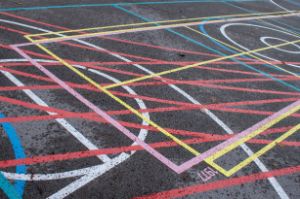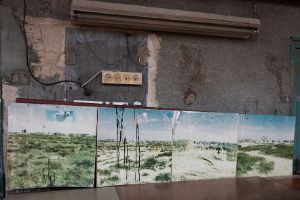
Berliner Festspiele 70
The biography of an institution
From their very beginning, the Berliner Festspiele were Berlin’s go-to organisation for things that were too complicated, too big, too expensive, too niche, too daring and too nerve-wracking. With their festivals, exhibitions, programme series and contests they were able to set significant landmarks, paving the way for numerous global careers and surviving a number of flops. Serving almost all aspects of art and culture, enquiring, representative and innovative in their thinking, hardly any event of international significance was missing from the Berliner Festwochen.
Drawing on the tradition of various summer festivals but also competing culturally and politically with socialist institutions and groups that also invited 26,000 young people from around the globe to a “World Festival” in East Berlin in 1951, it did not take long for the “Berliner Festwochen” (literally: festival weeks) to perform all year round as their theatre and music platforms rapidly became permanent fixtures.
Play, Rewind, Repeat
The first day of the inaugural Berliner Festwochen – 5 September 1951: all day crowds of people gather outside the Schiller Theater. Looking into the faces of these people today, six years after total defeat, after nights of bombing and house-to-house fighting, mass rapes and freezing cold, it is simply incredible that Wilhelm Furtwängler, the former Vice-President of the Chamber of Music during the Third Reich, who had simultaneously resisted many of the rules of the Nazi regime, will be conducting once again and that in the midst of this city of ruins it is time for FESTWOCHEN. The Berlin Philharmonic, who performed on that first evening with Furtwängler, were finally heard in a representative setting again. At that time, isolated West Berlin was anything but a world-famous city of grand theatres and concert halls. Both the historically prestigious and most modern theatres of the time lay in the East of the city. The newly-founded German Democratic Republic had not only succeeded in re-opening famous theatres such as the Deutsches Theater and the Volksbühne much faster, in Helene Weigel, Bertolt Brecht and Hanns Eisler they were able to call upon qualified people to relaunch their culture. During this period, when the Berliner Festwochen were founded, exchange between the two parts of Berlin was strictly forbidden and the first anti-Eastern campaign was in already full swing. The Berlin press told its readers: “West Berliners. It should be obvious to you not to support any of the institutions in the Eastern Sector controlled by the Soviet state. No West Berliner should visit an Eastern ‘state theatre’. No West Berliner should read an Eastern newspaper.” (Erik Reger, ‘What For?’, in: Der Tagesspiegel, 5 December 1948.)
However, if we look at the second day: Boreslaw Barlog, the new Artistic Director of the Schiller Theater that had been re-opened the day before, directed at Theodor Heuss’s suggestion Schiller’s ‘Wilhelm Tell’ as a drama of liberation. On the new stage all the tyrant’s insignia were symbolically thrown on the scrap heap – but who was excluded from the play? That’s right: East Berlin. In keeping with custom, the Artistic Director Barlog had invited his colleagues from the other theatres in the city, not suspecting that on the day of the premiere he would be embarrassingly forced to disinvite the artistic directors from East Berlin at the insistence of Culture Senator Joachim Tiburtius.
The Berliner Festspiele are many stories
There is the story of the post-war years, in which the Allies created a window display for art from the “free world” with the Berliner Festwochen and the Berlin International Film Festival. There is the story of the city divided by the wall with Festtagen in the East and Festwochen in the West. There is the story of the continuity of now traditional festivals such as the “Theatertreffen” and “Jazzfest Berlin” and there is a story of the change that ran through them, accompanied by the constant invention of experimental formats and temporary structures.
There is the story of having far too few women in the programme and in leading positions and the present story of the quota of women at the Theatertreffen. There is the story of influential formats such as the “Metamusic Festival”, “Horizons – Festival of World Cultures”, the “Music Biennal Berlin”, “Aktionen der Avantgarde” (ADA) and “The New Infinity. New Art for Planetariums”.
There are also the stories of the artistic directors with their artistic priorities, networks and cultural political strategies, and the stories of generations of members of staff who poured their passion, their expertise, thousands upon thousands of working hours and their endless creativity into putting together festivals – and still do. There is the parallel story of the Festtage in East Berlin with their excellent programme in no way inferior to the Berliner Festwochen and their unspeakable treatment in 1990. There is the story of the radio bridge that was used to get around the newly erected wall and the new On Demand platform, thanks to which the Berliner Festspiele, their archives and festivals can be accessed by an audience spread around the entire globe both during and after the time of coronavirus.
There is the story of programming in the Gropius Bau and the Haus der Berliner Festspiele, and there is the story of the long period before the Berliner Festspiele operated these two venues, when they worked as guests at practically every other venue in the city (co-)producing large, experimental performances, symposia and exhibitions. There is the story of these hundreds of venues – many have since become defunct or repurposed while others remain prominent features of Berlin’s cultural landscape. And there are the stories of the countless partner institutions who have enriched and helped to shape the Berliner Festspiele’s programmes.
There are stories of excess and subtlety, representation and innovation, of roots in Berlin and a fascination with the world beyond Europe, of intense successes and painful failures, of the tingle of expectations and ever receding memories.
And there are the many, many untold stories.
What still stands out now?
Athletics and boxing matches, Brecht theatre from Syria, Hildegard Knef’s tales of Mexico in the talks series “Berliner Lektionen”, the concept of carbon neutral exhibitions, Brian Eno, John Cale and Nico with their version of the German national anthem at the Nationalgalerie, Martin Luther King Jr.ʼs opening speech commemorating John F. Kennedy, Ilya Khrzhanovsky’s unfinished DAU project on Unter den Linden, Fela Anikulapo Kuti and Africa 70 in the elections, puppet ballet from Milan, John Cage and Merce Cunningham’s performances in Europe, a conversation with the founder of the Living Theatre Judith Malina in the Berliner Lektionen, an entire festival devoted to circus, Erwin Piscator’s battle with opera, convoluted modern jazz from Russia, hours of debate broadcast live on TV in the 1960s, Bert Neumann’s subversive set designs and costumes, sculptures and open-air studios outside the Philharmonie, Boris Blacher’s ballets withTatjana Gsovsky, Ida Müller and Vegard Vinge’s National Theatre in Reinickendorf, the Topographie des Terrors, Pina Bausch’s dance works at the Theatertreffen, griots from Mali, kabuki and nō drama from Japan, folk songs from Germany and model opera from China and Wolf Vostell’s environments on the site of the wall. There we also meet Gordon Matta-Clark and Ulrike Ottinger; we see theatre without actors, Allan Kaprow on staircases and Ulrich Papenberg in the gallery space, George Maciunas and Shigeko Kubota with Fluxus on the harpsichord, shallow civilities and from a contemporary perspective dubious concepts about the co-called “third world”, Luca Ronconi’s medieval tournament at the Deutschlandhalle and Joseph Beuys at the Gropius Bau, legendary performances by Igor Stravinsky, Wolfgang Rihm, Luigi Nono and Vladimir Horowitz; Fassbinder’s far too rare excursions into theatre and Schlingensief’s art exhibitions on stage, visual art from Africa, from North and Latin America and Asia and all the people who came and looked, listened, laughed, booed, applauded, discussed and went away again.
